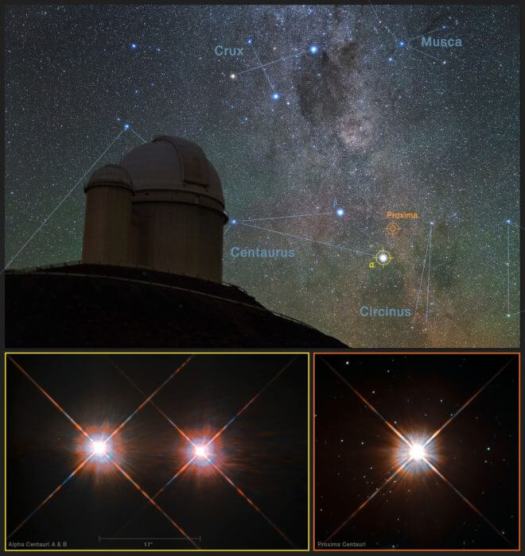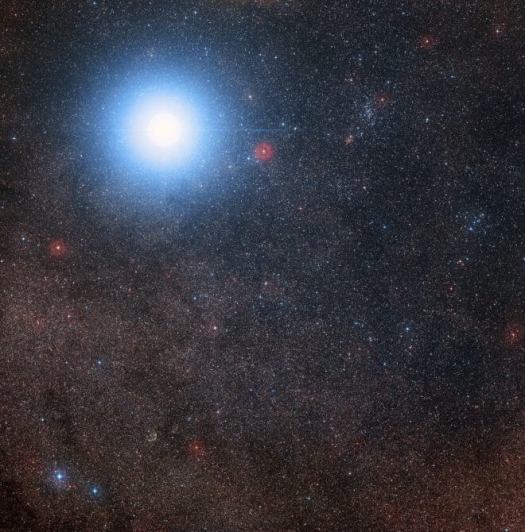
dwarf star Proxima Centauri, the closest star to the Solar System. The double star Alpha Centauri AB also appears in the image. Proxima b is a little more massive than the Earth and orbits in the habitable zone around Proxima Centauri, where the temperature is suitable for liquid water to exist on its surface.
(ESO/M. Kornmesser)
No exoplanet can possibly be closer to us than the one just detected around our nearest stellar neighbor, Proxima Centauri.
The long-sought and long-imagined planet is larger than Earth, but small enough to be rocky as opposed to a gas or ice giant. Making things even more exciting, the planet was detected inside the habitable zone of Proxima, suggesting that the planet could potentially have temperatures that allow for pooling liquid water.
Innumerable questions remain to be answered before we know if it actually is habitable (as opposed to residing in a habitable zone), and far more before we know if it might actually be inhabited.
But the very exciting news is that an exoplanet has almost definitively been found only 4 light-years from our solar system. There’s every reason to believe it will become the focus of intense and sustained scientific scrutiny.
The detection is the culmination of a “Pale Red Dot” observing campaign that began in earnest early this year to search the regions close to Proxima for exoplanets. Guillem Anglada-Escudé of Queen Mary University, London, was a leader that campaign, as well as earlier efforts to dig deeper into decade-old Proxima Centauri data from other teams that hinted at a planet but were far from definitive.
“The signal that a planet orbits Proxima every 11 days is strong, so we have little doubt that it’s there,” AngladaEscude´ said. “And because this is the closest possible planet outside our solar system, there’s a sense of finding something special, even inspirational.”
His hope is that the detection will become a global “driver,” a discovery that is significant enough to change how people think about our world, as well as about the possibility that some day humans will explore up close a planet outside our system.
Said Anglada-Escude´: “The search for life on Proxima b comes next….”

Indeed, it already has started. Excitement in the exoplanet world is palpable, and papers based on the finding are already on their way to the public. Anglada-Escude´ gave early copies of the Proxima paper to a number of groups around the world so they could begin digging deeper.
One such group was the Virtual Planetary Laboratory at the University of Washi
ngton, and director Victoria Meadows and research assistant professor Rory Barnes have been looking at and modeling the possible evolutions of Proxima b and how its potential for habitability can be assessed in the years and decades ahead.
“This is a huge discovery,” said Barnes. “Before Proxima b, we didn’t really know what planet would be of greatest interest, so we had to prepare for whatever we might find.
“Now it’s no longer a question of what is the prime target, where do we want to first focus and dig deep. Now we know exactly what we want to look at.”
Barnes’ paper will focus on models of the possible evolutions of Proxima b, while Meadows will focus on what researchers should look for in terms of habitability on the planet and what current and future instruments would be best suited for the search.
“The planet is in the habitable zone, but that doesn’t mean it’s habitable,” Meadows said. “What we’re focused on is what are the surface conditions now, the atmospheric make-up, whether or not there might be an ocean present. These are very difficult questions to address, and it will definitely take time to develop the instruments we need and for the community to find answers.”

Proxima Centauri is a red dwarf (or M dwarf) star, a very long-lived but small and cool star compared to our sun. Red dwarfs are the most common type of star in the galaxy, by far. To date, however, only a few Earth-mass planets have been discovered in the temperate zones of such stars. But because there are countless billions red dwarf stars, only a small percentage need to have temperate-zone planets to make our galaxy potentially teeming with life.
When it comes to the odds of finding an exoplanet orbiting the star nearest us, I turned to Natalie Bathalia, project scientist for NASA’s Kepler Space Telescope. Based on statistical analysis of Kepler survey data, she said, we should expect at least one potentially habitable, Earth-size planet orbiting an M dwarf (or red dwarf) star within 10 light-years of the solar system.
“Well, it turns out that there are only 7 M dwarfs within 10 light-years of the solar system,” she said. “That means we’re ‘roll-of-the-dice’ lucky, not ‘winning-the-lottery’ lucky. Had it been the latter, I might have been more skeptical. Instead, I’m relishing the moment. Numbers aside, I’m certainly feeling like we’ve all just won the cosmic lottery.”
As described in a cover article in the journal Nature, Proxima b was identified by the “Doppler wobble” of its host star — the effect caused by the planet’s gravitational pull. This method was used to discover the first exoplanet around a sun-like star, 51 Pegasi, in 1995.

Astronomer Paul Butler of the Carnegie Institution for Science was one of the two scientists who made the essential confirmation of that first exoplanet, and he played an important supporting role in the Proxima b detection as well.
“We’ll continue finding planets, but this may well be the last big deal detection,” Butler said. “There may be even more important planets out there, but it’s pretty hard to imagine what they might be.”
The Doppler method is particularly useful and effective in studying or red dwarf stars. Because these stars are cooler than our sun, their potentially habitable planets would orbit much close to the host star (about one-tenth of the sun–Earth distance,) and so are potentially easier to detect.
These red dwarf stars are also less massive than the sun, and so are more visibly affected by the presence of an orbiting planet. A Doppler wobble for a red dwarf with exoplanets is large enough (about 1 meter per second) to be detected by current instruments. By comparison, Earth causes a Doppler wobble of the sun of 0.09 meters per second.
Anglada-Escudé and colleagues first detected a possible signal of their exoplanet using Doppler measurements taken by the Ultraviolet and Visual Echelle Spectrograph at the European Southern Observatory (ESO) in Chile between 2000 and 2008.
These data showed a hint — but not an entirely convincing one — of a Doppler wobble of 1.38 meters per second. With the help of Butler, they also re-analyzed date from an earlier Proxima run using the ESO’s High Accuracy Radial velocity Planet Searcher (HARPS) spectrograph in Chile.
The authors confirmed the signal by using many more Doppler measurements taken in 2016 with the same spectrometer and telescope. Nonetheless, to be on the safe side, Proxima b is still formally called a “candidate” exoplanet.

The Pale Red Dot campaign has been aimed at Proxima, but plans to continue looking for exoplanets orbiting nearby red dwarf stars. The group includes 31 scientists from eight international and national organizations, and shares its news on this site: https://palereddot.org/.
The name of the campaign plays on the “pale blue dot” image of the Earth taken in 1990 by Voyager 1 on its way to interstellar space. The phrase was later used by Carl Sagan, who lobbied for Voyager to make the necessary maneuvers to take the images, for his essay, “Pale Blue Dot: A Vision of the Human Future in Space.”
I spoke recently with Anglada-Escude´ about the campaign and its breakthrough Proxima b detection. Both clearly flow from his deep interests and drives.
“I’m a scientist and I’ve been excited about exoplanets for a long time. But when I was young I read a lot of science fiction, I was a geek I guess. Proxima and the Centauri system always seemed like the next place to go — not now, but in a few hundred years. But to do this we had to learn all about the stars and hopefully the planets around them. So you could say that none of this happened by chance.
“So this is all about detection and characterizing the planet and star, but about exploration as well. It’s the nearest object outside of our solar system, and that makes it a natural destination.
“We know the planet is there, so now is the time for people to get creative about imaging it, and learning how to search for life there, and ultimately set out on interstellar expeditions in that direction.”
Proxima Centauri, it should be noted, is 266,000 times as far away as the distance from the Earth to our sun.

